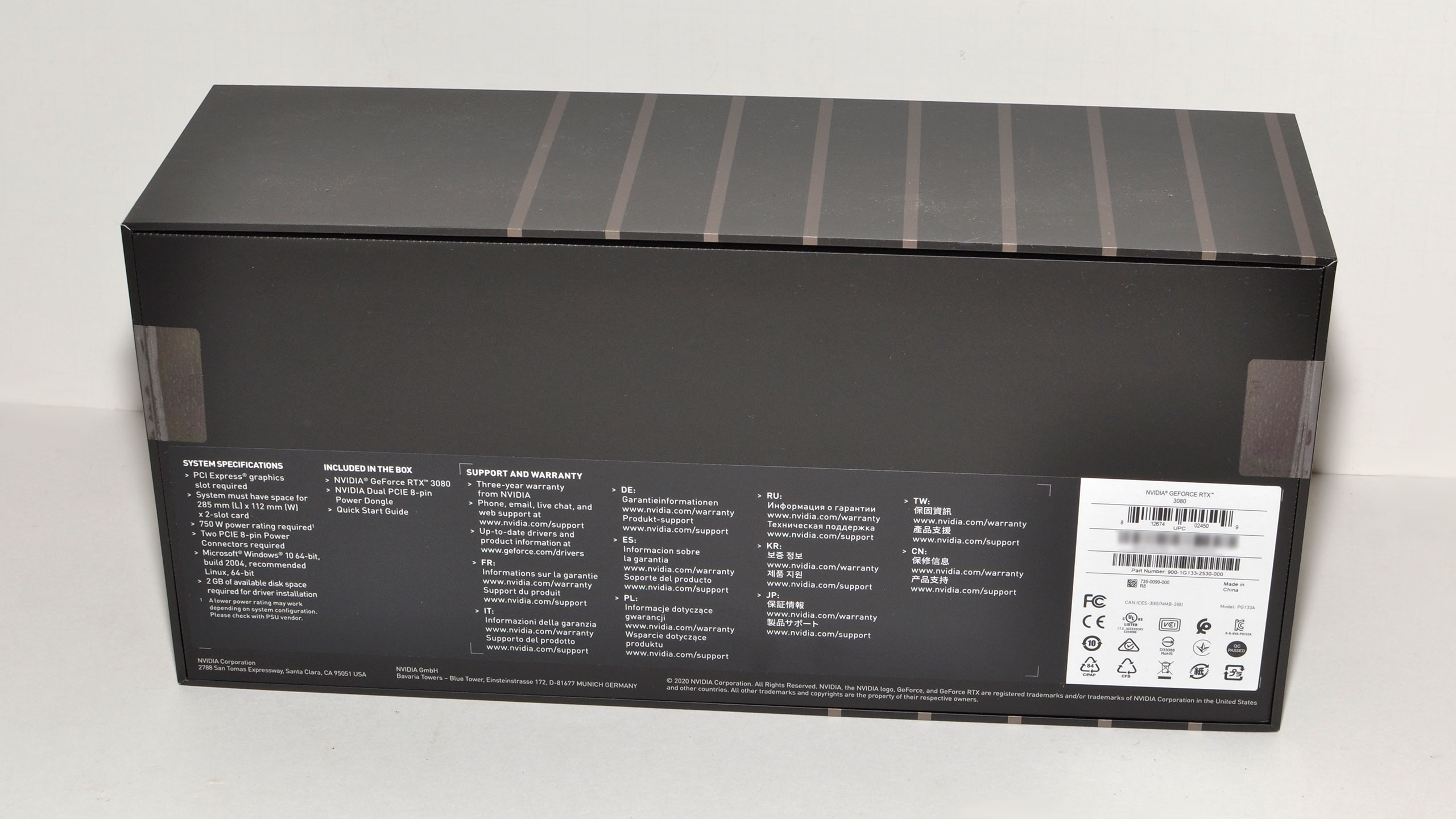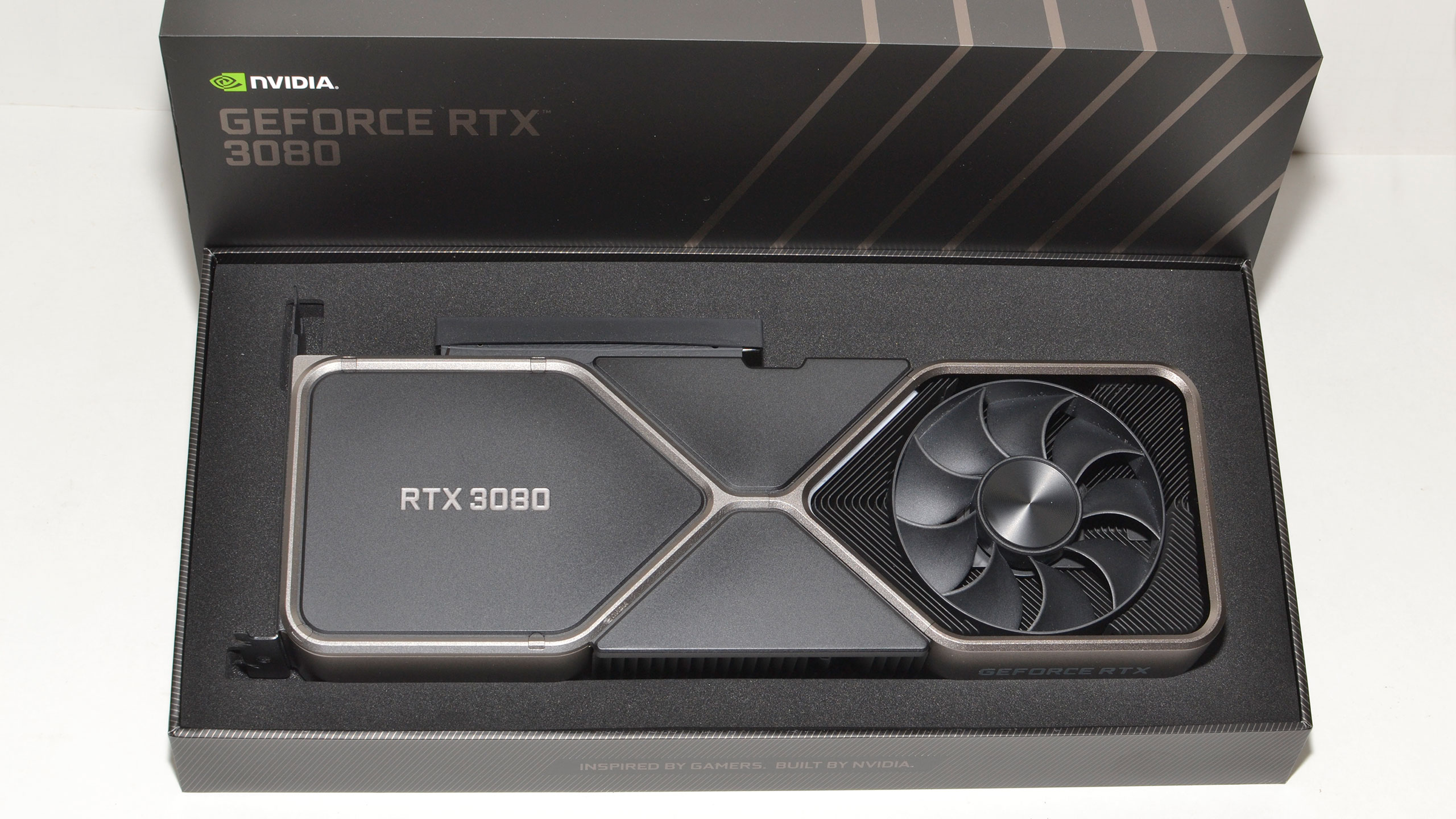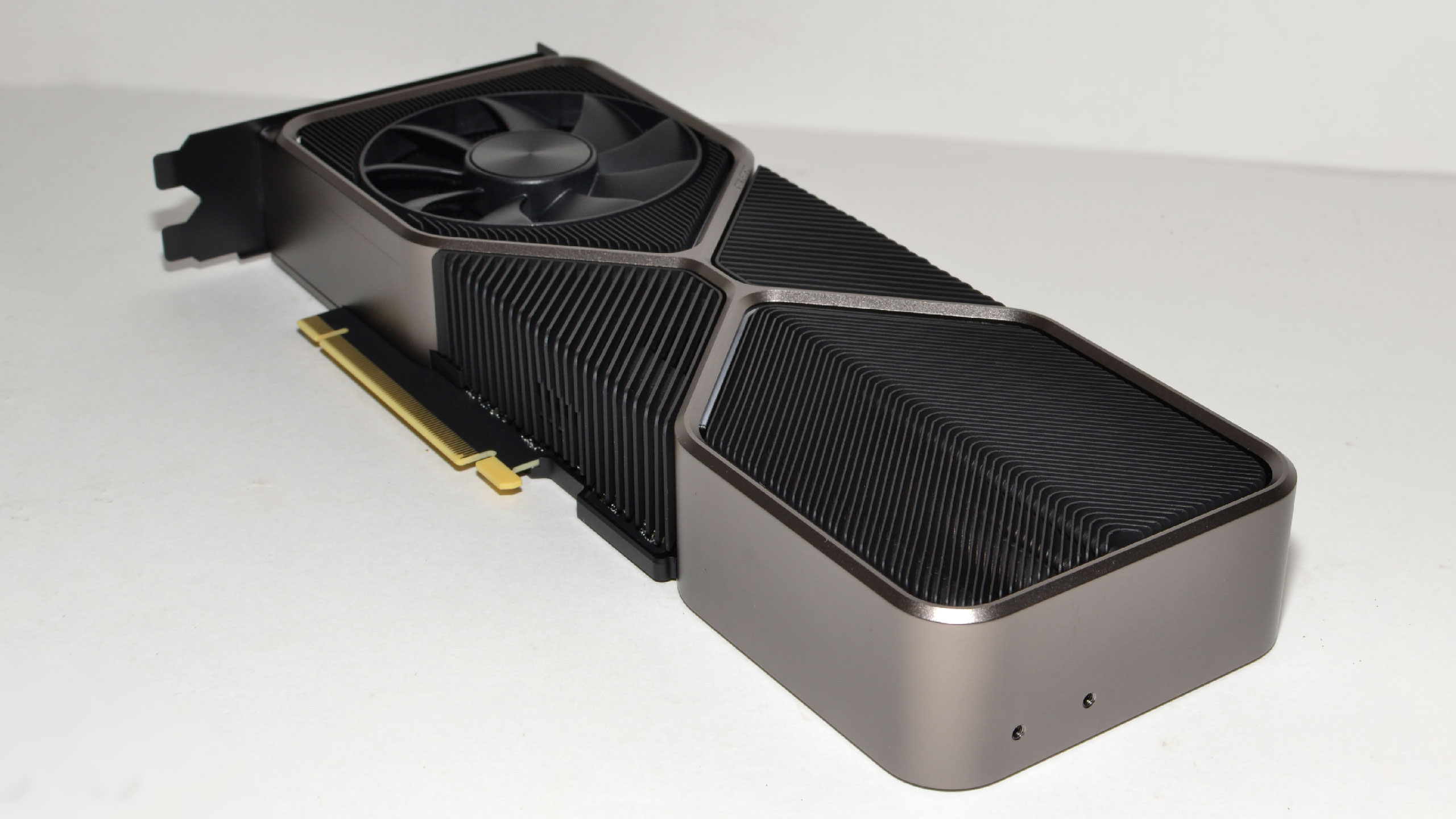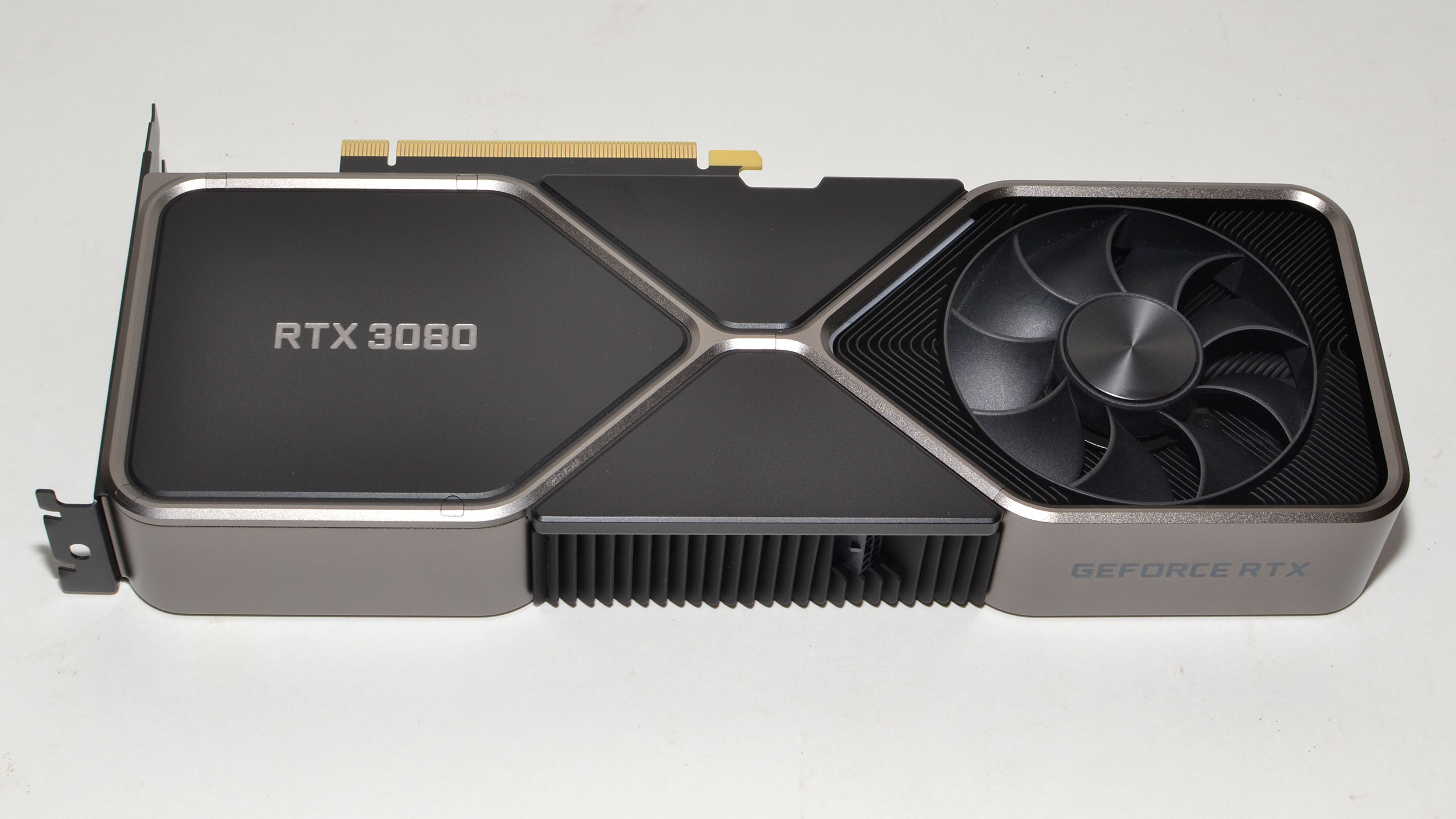Nvidia GeForce RTX 3080 Founders Edition Hands On and Unboxing
Sorry, no benchmarks yet!
Nvidia's GeForce RTX 3080 is nearly here! Well, actually it is here, in our labs, right now. It's been more than two years since Nvidia launched a truly new GPU, and the Ampere architecture promises to power Team Green's best graphics cards for at least the next year, and probably longer. Everything from the top-shelf GeForce RTX 3090, which is a gaming and consumer branded Titan with a price to match, down through GeForce RTX 3070, and probably even 3060 and 3050 cards eventually, depends on Ampere.
How good is it? Can it possibly live up to the hype? We can't say, at least not this week. Check back next week for the official launch and we'll have plenty of benchmarks. Today, what we can do is show you the card and discuss the design and aesthetics.
Without further ado, here's the full gallery of the RTX 3080 Founders Edition packaging and materials, plus various product shots.















We also did a live unboxing on YouTube... and my internet failed in the middle of the stream, leaving me with shaky iPhone handheld video. Still, we talk a lot about the architecture, power requirements, and more in the video.
I have to admit, when I first saw the leaked product shots of the RTX 3080 Founders Edition, I thought it looked a bit ugly. That's probably because they were crappy smartphone pictures and the card was half covered in yellow plastic. In hand and in person, the card looks quite good. It also feels very solid — the fins on the radiator aren't super flimsy and prone to bending, which is one less item to worry about.
Nvidia radically altered the cooling setup this round, which was perhaps necessary to cope with the 320W TDP. Or maybe not — we'll certainly see more or less traditional cooler designs from Nvidia's AIB (add-in board) partners. In fact, we've already seen plenty of product announcements and images: Asus and Gigabyte have a bunch of cards coming, EVGA's RTX 3090 FTW3 boasts high overclocking potential, and we've seen third party card pricing appear.
I've mentioned this before, but I'm really happy to see the change in cooler design compared to the previous RTX 20-series Founders Edition cards. They looked nice enough, but in my experience the backplates on the 2070 Super and above can all get very toasty even at stock settings — I'm talking surface temperatures of 80C or more, particularly on the 2080 Super and Ti! The RTX 3080 through-flow back fan should certainly be a change for the better.
Get Tom's Hardware's best news and in-depth reviews, straight to your inbox.
Nvidia also says the cards will run quieter, even while dissipating more heat. That's something we're looking forward to testing, but it's not super difficult to come up with ways to dissipate more heat. The easiest way is the brute force approach: just make everything bigger! More fans, bigger coolers, AIO coolers, etc. have all been tried. There were quite a few triple-slot GPUs with the 2080 Ti and 1080 Ti, or at least 2.5-slot designs, and they all tend to run quite a bit cooler than dual-slot designs.
The GeForce RTX 3080 Founders Edition already incorporates this 'bigger is better' idea in the design, of course. Physically, the RTX 3080 FE is nearly an inch longer than the RTX 2080 FE. It's also slightly heavier — we weighed the 2080 FE at 1260g compared to 1355g for the 3080 FE. That's about 30g heavier than the Titan RTX, RTX 2080 Ti, and RTX 2080 Super, if you're wondering.
Aesthetically, the new radiator definitely looks different, and maybe dust build-up will be more visible over time. That's probably for the best, though: If you can see dust on your GPU's cooling fins, it's a good time to pull out the canned air and clean it. We have seen and experienced overheating GPUs plenty over the years, and at least the back portion of the card should be easier to clean out.
The second front fan (calling the video ports of the card the front) functions as a blower-style fan, though it's still an axial fan and not the radial style fan used on the GTX 10-series and earlier reference designs. That means the RTX 30-series Founders Editions will land somewhere between the RTX 20-series and the GTX 10-series, venting more heat outside the case than the former, but still adding more heat to the case interior than the latter.
We're also told that disassembling the new Founders Edition cards will be a bit more complex than on previous models, thanks to the changes in board and cooling design. That's potentially a concern for anyone looking to swap out the cooler for a waterblock, though if you're planning on doing that it's still possible.
There's not too much else to say about the design and accessories, other than a quick discussion of the funky 12-pin adapter cable. I'm still not at all convinced this was necessary or even a good idea, but it's here now and we get to live with it. All RTX 30-series Founders Edition cards appear to use the 12-pin connector, and all of the cards that use it will also include a dual 8-pin to 12-pin adapter cable.
Down the road, we'll see PSUs start to natively support the 12-pin connector, at which point we'll also likely see GPUs move beyond the current 375W power limit imposed by two 150W 8-pin PEG with the 75W PCIe slot. That's a bit worrying in itself (450W GPUs!?), but we'll cross that bridge when we come to it.
The interesting thing about the 12-pin connector is that the specs sheet says it's only rated for 25 cycles. That means, potentially, it might not hold up so well over time. I'm not sure that's a meaningful spec, however. What are the current 6-pin and 8-pin connectors rated for in terms of cycles? I swap GPUs in my test beds nearly every day, which means after several years some of my power supplies are certainly well over 1000 cycles, and they still seem to be doing okay.
But that doesn't even matter for most end users that will rarely if ever swap GPUs, and certainly not on a daily basis. More to the point, since most of us will need to use the adapter cable, and since every card that uses the 12-pin connector also includes such a cable, I plan to just leave the adapter connected when the card isn't in use.
That's it for now. The GeForce RTX 3080 Founders Edition is in our labs, and it looks pretty sweet. But I'd be lying if I didn't say that what I'm really looking forward to is the RTX 3090 Founders Edition. That thing is friggin' huge, and I love it. It just makes me want to scream "MOAR POWER!" or something.
It's not going to work at all in small form factor cases. In fact, even the RTX 3080 FE is going to be a tight fit in smaller PCs. There's also a bit of concern about how the back fan venting directly into the CPU and RAM area will affect temperatures on those components, but considering the PC case is a closed system, I can't imagine it will be much worse than any other open-air cooler design venting into your case interior.
The GeForce RTX 3080 officially goes on sale on September 17, and current indications are that it's not just Nvidia's Founders Edition, based on some of the pre-orders and pricing links for partner cards that have been popping up. Hopefully there's enough cards to go around (there probably won't be, at least initially), because plenty of people that skipped the previous generation of GPU upgrades have been eyeing this round for upgrades. Check back next week for our full review.

Jarred Walton is a senior editor at Tom's Hardware focusing on everything GPU. He has been working as a tech journalist since 2004, writing for AnandTech, Maximum PC, and PC Gamer. From the first S3 Virge '3D decelerators' to today's GPUs, Jarred keeps up with all the latest graphics trends and is the one to ask about game performance.
-
st379 Are you even going to bother with 1080p benchmarks :)?Reply
Would love to see pci-e 3 vs pci-e 4 benchmarks. -
RodroX Despite the probable big jump in performance, (the following is my personal opinion) what a a boring looking card (and Im not talking about RGB or any of that), it just looks like a dull enterprise product and not something that really catch the eye at first glance.Reply
Nothing that will really show up on a glass case. Probably hard to see it on one of those dark tinted glass.
Anyways, lets hope the performance numbers showed live up to the expectation on the vast majority of games. -
digitalgriffin I'm not a huge nvidia fan based on their business practices. But I have to sayReply
Daddy likes. -
JarredWaltonGPU Reply
I am! But obviously anyone buying this card hopefully isn't focused on 1080p gaming. Even the 2080 Ti was basically overkill at 1080p (unless you enable ray tracing). As for PCIe Gen3 vs. Gen4, I'm planning on testing with Ryzen 9 3900X and Gen4, but that's a different platform and CPU than i9-9900K and Gen3. It might make a difference at 4K, though. Maybe? Like, when you're GPU limited at 4K the added PCIe bandwidth might be useful. Next week ... start the 7 day countdown to launch day! :Dst379 said:Are you even going to bother with 1080p benchmarks :)?
Would love to see pci-e 3 vs pci-e 4 benchmarks. -
JarredWaltonGPU Reply
1355g, compared to 1260g on the RTX 2080. So 100g more (roughly) than the previous gen. I'm really curious to see how much the 3090 weighs, though! My case might need some reinforcing to hold that up over time. 😲DookieDraws said:Looks mighty heavy. Looking forward to the review. -
InvalidError Reply
I'm not expecting 3.0 vs 4.0 to make much of a difference until GPUs are pushed beyond their VRAM size, which may require 8k texture packs at 10GB.st379 said:Would love to see pci-e 3 vs pci-e 4 benchmarks. -
st379 Reply
If my memory serve me right the rtx 2080 ti already shows couple precent different.InvalidError said:I'm not expecting 3.0 vs 4.0 to make much of a difference until GPUs are pushed beyond their VRAM size, which may require 8k texture packs at 10GB.
Unfortunely i don't have a link to where i saw it.
Edit: HardwareUnboxed video. Extra 5 fps over pci-e 4.0



